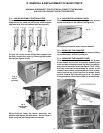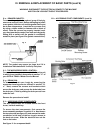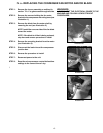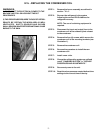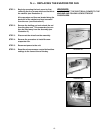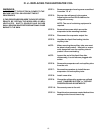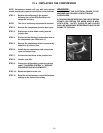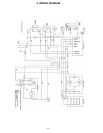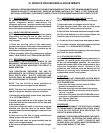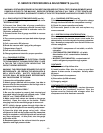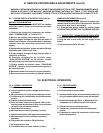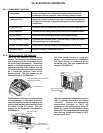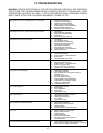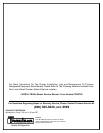
-12-
VI. SERVICE PROCEDURES & ADJUSTMENTS
WARNING: CERTAIN PROCEDURES IN THIS SECTION REQUIRE ELECTRICAL TEST OR MEASUREMENTS WHILE
POWER IS APPLIED TO THE MACHINE. EXERCISE EXTREME CAUTION AT ALL TIMES. IF TEST POINTS ARE
NOT EASILY ACCESSIBLE, DISCONNECT POWER, ATTACH TEST EQUIPMENT AND REAPPLY POWER TO TEST.
VI. a - SYSTEM ACCESS:
All external indicators should be checked as part of
system diagnosis before determining the
refrigerant pressures. Improper access may expose
the refrigerant to contaminates and non-condensables
which will result in system failure.
VI. b - SWEAT-ON PIERCING VALVES:
NOTE: Sweat-on piercing valves are used for system
diagnostics, but may be left on after service is
complete. They may be installed while the system is
fully charged.
1) Place one piercing valve on the compressor
process tube and one on the liquid line process tube.
Follow the installation instructions provided by the
manufacturer of the piercing valve.
2) When complete, follow the guidelines as outlined
under “LEAK CHECK” and “EVACUATING SYSTEM.”
VI. c - REFRIGERANT LEAK CHECK:
DISCONNECT THE ELECTRICAL POWER TO THE
MACHINE AT THE MAIN CIRCUIT BOX. PLACE A TAG
ON THE CIRCUIT BOX INDICATING THE CIRCUIT IS
BEING SERVICED.
THIS PROCEDURE REQUIRES THE USE OF
REFRIGERANTS. BE CERTAIN THE WORK AREA IS
WELL VENTILATED. SAFETY GOGGLES AND
GLOVES SHALL BE WORN SINCE REFRIGERANTS
MAY CAUSE BURNS TO THE SKIN.
NOTE: The use of R-22 in small quantities is
recommended as a trace gas for leak detection.
NOTE: This leak check procedure is to be used only
after the refrigerant has been properly reclaimed.
1) Access the refrigeration system (note: see section
“V. a - SYSTEM ACCESS”).
2) Attach gauge manifold set to the system, low side
to process tube on the compressor and the high side
to the process tube.
3) Connect refrigerant bottle to the center of gauge
manifold and open the valve on the bottle. Bleed
charging hose at the manifold gauge to remove air from
the system.
4) Open valve on low side of gauge manifold and
charge system with one ounce of R-22.
5) Close low side valve on gauge manifold and the
valve on the refrigerant bottle.
6) Disconnect refrigerant bottle and connect nitrogen
bottle.
VI. c - REFRIGERANT LEAK CHECK (cont’d):
NOTE: The use of a nitrogen requlator is required.
7) Set output valve on nitrogen valve to 120 psi.
8) Open nitrogen bottle valve and low side gauge
manifold valve. Allow pressure to equalize.
9) Shut off both valves and disconnect nitrogen bottle.
10) Use a leak detector or a thick soapy solution and
check for leaks at all tubing connections.
A - If leaks are found, repair leaks and repeat process.
B - If no leaks are found, evacuate system as outlined
in section “V. d - EVACUATING SYSTEM”).
11) Charge the system by weighing in the exact charge
and check for proper operation.
VI. d - EVACUATING SYSTEM:
Introduction - Refrigeration reclaiming equipment is
required. Our goal in system evacuation is to remove
all the non-condensables possible. No evacuation
method will remove 100% of the moisture and air from
within the refrigeration circuit. Because of this,
guidelines and methods must be developed and
adhered to ensuring only harmless amounts of
contaminants remain in the system.
GUIDELINES
WARNING - DO NOT PRESSURIZE SYSTEM ABOVE
150 PSIG. PRIOR TO EVACUATION OR DURING LEAK
TEST PROCEDURES.
• Use only a two stage vacuum pump (2 CFM or
greater) and electronic micron.
• Evacuate from high and low sides of the system.
• No chemical additive or alcohols are to be used to
“dry up” a system.
• Blow down of system with DRY NITROGEN prior to
evacuation is acceptable and many times desirable.
See “System Clean-Up.”
• Evacuate to 200 microns.
PROCEDURE
WARNING: DISCONNECT THE ELECTRICAL POWER
TO THE MACHINE AT THE MAIN CIRCUIT BOX. PLACE
A TAG ON THE CIRCUIT BOX INDICATING THE
CIRCUIT IS BEING SERVICED.
WARNING: THIS PROCEDURE REQUIRES THE USE OF
REFRIGERANTS. BE CERTAIN THE WORK AREA IS
WELL VENTILATED. SAFETY GOGGLES AND
GLOVES SHALL BE WORN SINCE REFRIGERANTS
MAY CAUSE BURNS TO THE SKIN.



